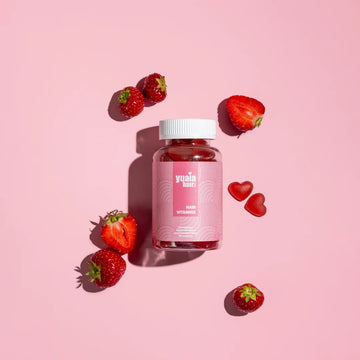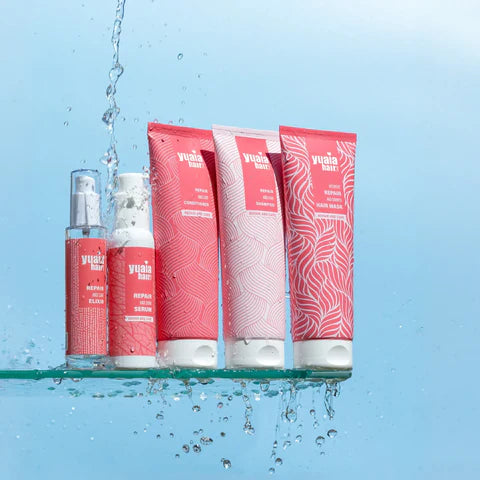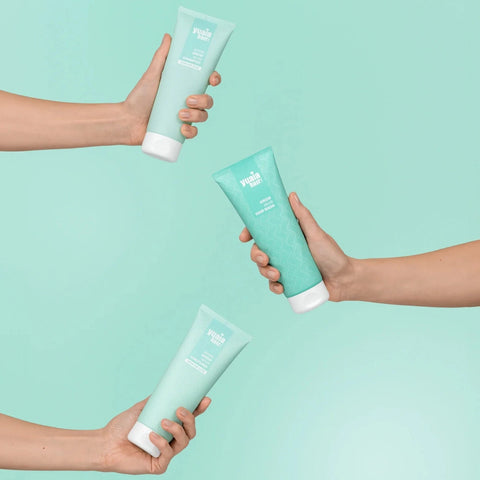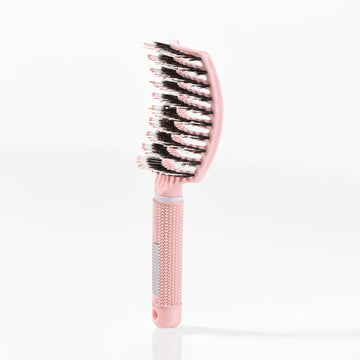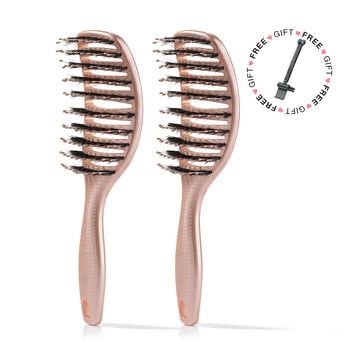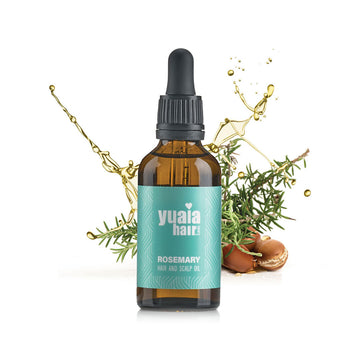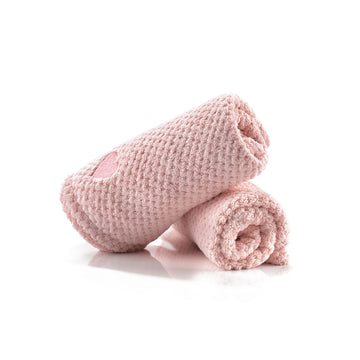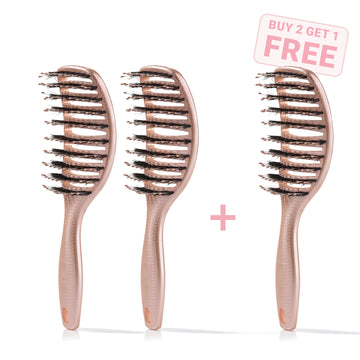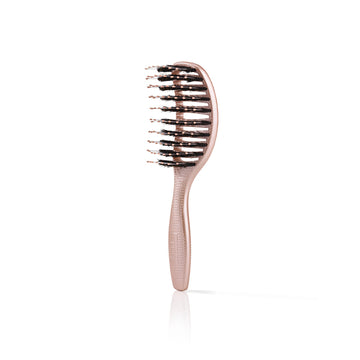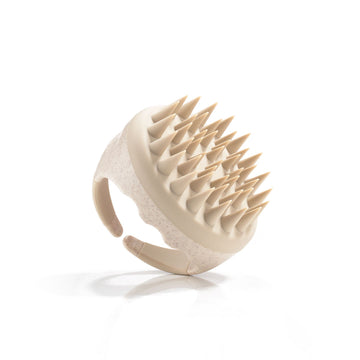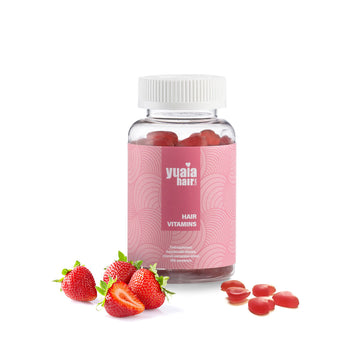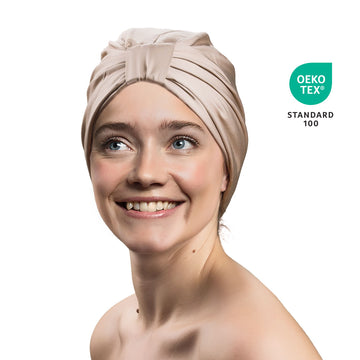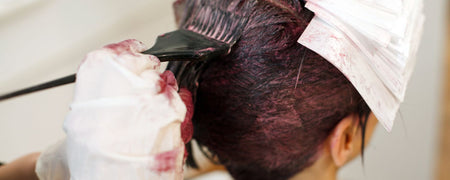
Colored hair: What you need to know about chemistry and health

by Nanna Bundgaard | 07. June 2023 | Reading time: 17 minutes
Read more about the authorColored hair can be a great way to experiment with your look. But have you ever thought about what hair color products do to your hair and your health? It's important to understand the effects of chemistry on your locks so you can make informed choices. Read on for our tips for healthier hair coloring and how colored hair affects your health.
What is colored hair?
Dyed hair is a popular thing that many women choose to do to achieve a new look. Coloring the hair usually involves the use of chemicals to change the color of the hair from its natural shade. This can be harmful to the hair if it is not properly taken care of with proper care and treatment such as cure and careful washing.
It is important to remember that coloring your hair can have an impact on your hair quality and health. It often requires more maintenance than natural hair, so make sure you read about the different types of hair dye and the ingredients in the products that can have a negative effect on your hair, as well as how to best take care of your colored hair after dyeing.
Brief history of colored hair
Hair coloring has been around for thousands of years. Already in ancient Egypt and Rome, hair was dyed with natural ingredients such as herbs, honey and saffron. But the modern dye, which uses chemicals to change the color of hair, was not invented until the mid-19th century.
Today, hair color is a billion dollar industry worldwide with countless products available to give you the desired color or shade. While it can be fun and exciting to try different things with your hair, it's also important to take good care of your hair. Here are some good tips for you:
- Do not wash your newly dyed hair within the first 48 hours after dyeing
- Always use a moisturizing regimen after coloring your hair
- Avoid frequent hair washing as this can damage both your new hair color and health
- Keep an eye on the chemicals in your products ingredients list

How often should you colour your hair?
The frequency of hair colouring depends on several factors, including hair colour, hair growth rate and personal preference. Generally speaking, hair colouring may need to be done every 4-6 weeks to maintain a fresh colour, especially if you have grey hair or want to hide growth. However, some people may find it necessary to colour their hair more frequently, especially if they have a lighter hair colour or if their hair grows quickly. It's important to follow the recommendations of your hairdresser or colour manufacturer for best results and to avoid damage to your hair.
Different types of hair color
Permanent hair color permanently changes the pigment in your hair, while semi-permanent hair color penetrates the outer layer and fades gradually. There are also temporary colors that sit on top of the hair and wash out after a few shampoos.
When considering coloring your hair, there are several things to take into account. Permanent coloring can have stronger chemicals than semi-permanent or temporary options, so it's important to follow the instructions carefully and use a deep conditioning treatment after coloring to minimize damage to the hair.
Chemistry in hair color products
Ammonia is an important ingredient in hair dyes as it helps pigments penetrate deep into the hair shaft. But it can have side effects such as dryness and damage to the hair, so it is important to use a good regimen after coloring.
Bleaching agents are used to lighten or remove existing dyes from your hair and can be very aggressive to the hair. Therefore, you should always follow the instructions carefully and make sure to give your hair extra care after the treatment. Different chemicals like phenylenediamines (PPD) and resorcinol also help add color to your hair, but they can be allergenic in some people. Therefore, always make sure to read the ingredient list thoroughly before coloring your hair for your own safety.
Ingredients to be aware of
When you have colored hair, there are some ingredients that you should pay special attention to. Sulfates can dry out your colored hair and damage it, while parabens can irritate your skin or even disrupt your hormones. And phthalates? They actually affect reproductive health and quality of life. It is important to read the ingredient lists carefully and choose products with natural alternatives to these harmful things if you want to have healthy and strong hair after a coloring or treatment. Here, among other things, it can be an advantage to use a shampoo without sulphate and silicone.
How does coloring your hair affect your health?
Coloring your hair can have an impact on your health, especially if you use products with harmful chemicals. Some women experience allergic reactions such as itching, rash or swelling of the scalp after dyeing their hair.
In addition, frequent coloring can lead to hair loss and damage to the hair structure. Therefore, it is always recommended to read the ingredient list carefully and choose more natural alternatives to protect your health.
Allergic reactions
Ingredients in hair dye that can trigger an allergic reaction:
Some ingredients in hair dyes can cause allergic reactions, especially PPD (p-phenylenediamine). Other ingredients such as resorcinol and ammonia can also cause irritation or allergies. It is important to read the label carefully and avoid dyes with these substances if you have had a previous allergic reaction to them.
Risk factors for developing an allergy to hair dyes and how to test if you are allergic to hair dye:
If you already have a history of skin allergies or eczema, it increases your likelihood of having a negative reaction to hair dye. To test whether you are sensitive to PPD before dyeing your hair, it is recommended to do a patch test using small amounts of the dye on the skin 48 hours before the planned use. If redness, itching or other signs of irritation occur during this period, you should not use the product on your hair.
Hair loss
Dyeing hair is a popular practice to change one's appearance. But can it lead to hair loss? Many women worry about whether frequent dyeing of their hair will result in permanent hair loss or damage to the scalp. While coloring products are not necessarily to blame for hair loss, improper use and excessive use of the chemicals can be harmful to your hair.
Below you will find some tips to avoid or limit the risk of permanent hair loss after dyeing:
- Be sure to follow the instructions carefully on the selected product
- Choose a quality color from a recognized brand
- Try natural alternatives like Henna
- Give your hair time to recover between each color treatment
You should also pay attention to any reactions your skin has after using the product and stop using this method if it should prove problematic.
Finally, be sure to trim your ends regularly and give them a little extra care before your next treatment. In this way, you preserve both the length and strength of your locks!

Other health risks
Although ammonia is a common ingredient in hair dye products, it can have harmful effects on your health. Before making a decision, you should research the possible risks and consider alternative products or treatments.
Studies also show that frequent use of permanent colors can lead to side effects such as scalp irritation.
Homemade products can be an alternative to commercial brands, but it's important to do your homework and make sure the ingredients won't harm your hair or health. With the right information and care, you can achieve healthy and strongly colored hair without compromising your health.
Hairdresser's advice
With more than 14 years of experience, hairdresser Mie Iversen has built up a great deal of expertise in hair colouring and is what is known as a colour expert. Here she gives her best advice. See her instagram here.

How long does it take to colour my hair?
- Time... That's a good question. After 12+ years in the business, I have to admit that the time frame for me and my girls and women in the chair varies a lot. It depends on the techniques to be used, the look you want in addition to the look they already have, the health of the hair, how long/short the hair is, and how thick/thin the hair may be and is therefore very individual.
How much should I expect it to cost to get my hair coloured?
- The price here comes down to all of the above factors, as well as something that some people take for granted, but others don't even think about; how many years of experience is behind it? Add to that things like rent, water, heating, insurance, products to use in the salon, tax, VAT and finally, time, customer care like coffee, or in short, just everything you see when you walk into your chosen salon.
Are there some hair colouring techniques that are better than others?
- There definitely are. And then there's also the way each individual approaches their work. I believe in something as simple as "letting my chemistry work for me". By this I mean that there's not much a hairdresser can't do if and when they have their chemistry under control. There are a lot of colour systems out there, and after purchasing from the hairdresser, you should familiarise yourself with how the different brands work.
What are your best tips for after-care of coloured hair?
- It's your hairdresser's finest task to guide you in a way that they think is in line with the treatment you've had done. I myself make wash recommendations as well as before and after styling recommendations. I do this to ensure my client has the best experience with her new hair colour.
Tips for healthier hair coloring
Colored hair can be beautiful, but it is important to consider chemistry and health. To avoid dangerous chemicals in your hair colour, you can choose products without ammonia or parabens. Be sure to read the ingredient list on the package carefully.
Using natural hair color products can also help protect your hair and skin from harmful substances. You can find different plant-based products in stores or maybe even make your own homemade colors at home with ingredients like coffee or tea. By using these more natural remedies, you will likely experience less irritation and a healthier feeling in your hair after coloring.
Also remember that frequent coloring is not good for your hair! If you want a healthy and strong result, try to dye only once every 8-10 weeks - this gives enough time for the hair to rebuild its keratin structure again after the chemical process of dyeing. Make sure that your hair care in the period after provides a lot of moisture and care for the hair. Always remember good care before/during/after the treatments for optimal protection of your fine features!
We can highly recommend our Healthy Hair Kit, which helps to moisturize and care for the hair in between your hair dyes. They are full of delicious active ingredients that strengthen your hair and keep it in top shape. Find the set here.
Choose hair color without dangerous chemicals
When choosing hair dye, it is important to read the ingredients list carefully. Avoid dyes with ammonia and formaldehyde, as these chemicals can damage your hair and your health. Instead, choose brands known for safe and natural products that do not contain dangerous chemicals.
Using natural hair dyes can also be a good solution to avoid dangerous chemicals. These products often use plant-based ingredients such as henna or indigo to give hair color without the harmful side effects of traditional chemical dyes.
Be aware of the frequency of your hair coloring, as repeated treatments can lead to damage to your hair and even loss. Instead of changing your hair color every month, consider alternative methods such as tones, balayage, glossing or highlights for a less aggressive look.
Always remember the importance of the choice between health or style when making the decision on the right hair treatment.
Using natural hair color products
Try experimenting with vegetable dyes such as henna or indigo instead of chemical dyes that can damage your hair and health. These natural hair color products are not only safe but also nourishing for your hair due to the many beneficial ingredients. You can find a wide range of shades from these products, so you can choose the perfect color for you.
It is crucial to use a quality color from a reputable brand when choosing a natural hair color product. This will give you the best result and avoid any unwanted side effects. Before you start coloring your entire hair, always test the product on a small section first to check for any allergic reactions or unexpected results. By taking these small steps, you will be able to achieve beautiful and healthy colored hair without the worry of chemicals!
Be careful with frequent staining
Consider alternatives to permanent hair coloring such as toning or semi-permanent coloring. Permanent coloring can be harmful to your hair and scalp as it contains chemicals that penetrate deeper into the hair and can lead to dry and damaged hair over time. Toning or semi-permanent dyes are a good alternative as they do not contain ammonia or peroxide, which are known to be harmful.
Make sure to give your hair enough time between each treatment. Hair needs time to recover after a coloring treatment. Repeating treatments at shorter intervals than recommended will result in more stress on the hair and will increase the risk of damaged locks. Leave at least 6-8 weeks between each treatment depending on your hair type.
Always remember to care for your hair thoroughly with nutritious products after each treatment. Colored hair needs extra attention and care than naturally full hair, especially when it comes to the hydration of your locks; use moisturizing shampoos, conditioners and serum/oil based leave-in products regularly - this will help you keep your gorgeous look healthy!
Summary
Forget about dyes that can damage your hair and body. Go for healthier alternatives when it comes to choosing hair color. Check the ingredients carefully, as naturalness or certifications can be misleading. If you still choose to continue with frequent coloring, make sure to take good care of your hair to keep it healthy and strong. Your hair deserves the best treatment!
FAQ about colored hair
Can you dye your hair at home?
Yes, you can dye your hair at home with home dye, but it is important to be careful and follow the instructions carefully. It is also important to choose a quality color and take into account your hair color and type. If you have any doubts or concerns, it is best to seek professional advice or get help from an experienced friend. It may also be a good idea to do an allergy test before you dye your hair to avoid possible allergic reactions. Remember to take care of your hair with a good hair treatment after coloring to maintain healthy and strong hair.
Does your hair get damaged when you dye it?
It is a common concern among women that coloring hair can cause damage. The truth is, if you don't take the necessary precautions and care for your hair properly, it can lead to damage. But with the right care and attention, you can prevent damage and maintain healthy and strong hair.
It is important to find a qualified hairdresser who uses quality products. This can help reduce the risk of injury and give you the results you want. In addition, you can choose a color that is not too harmful to your hair. It is a good idea to choose a color that is close to your natural color as it will require less bleaching and dyes to achieve the desired result.
After coloring, it is important to take care of your hair. Use a good shampoo and conditioner that is specially formulated for colored hair or that provides special moisture and care. Here we can highly recommend our Repair and Care products, which give the hair a lot of moisture and care.
Can I colour my hair when pregnant?
It is generally recommended to be cautious about hair colouring during pregnancy, especially in the first 12 weeks. This is due to concerns about the potential effects of the chemicals in hair dyes on the foetus. While there is no clear evidence of harmful effects of hair colouring during pregnancy, it is often recommended to wait until the second trimester to minimise risks. Using natural or ammonia-free hair colours can also be a safer alternative during pregnancy. It's always a good idea to consult a doctor or professional hairdresser if you have any concerns or questions about hair colouring during pregnancy.
How do I get hair dye off my skin?
If you have hair colour on your skin, there are several methods you can try to remove it:
- Washing with soap and water: First, try washing the coloured area with warm water and mild soap. Rub gently with your fingers or a soft cloth to remove the colour.
- Use of oil: Oil can be effective at dissolving hair colour on the skin. Try applying a small amount of baby oil, olive oil or coconut oil to the coloured area and rub gently. Let the oil sit for a few minutes before wiping it away with a cloth or washing it off with soap and water.
- Using alcohol: If the oil doesn't work, try dipping a cotton swab or cloth in a little alcohol, such as rubbing alcohol or nail polish remover, and gently wipe the coloured area. Be careful to avoid the eyes and delicate areas.
- Lemon juice: Lemon juice is a natural bleach and can help lighten the colour on the skin. Apply fresh lemon juice to the coloured area and let it sit for a few minutes before washing it off with water.
- Commercial products: There are also commercial products available, such as hair colour remover or makeup remover, which can be effective in removing colour from the skin. Follow the instructions on the product carefully.
Always remember to be careful when trying to remove hair colour from the skin and avoid rubbing too hard as this can irritate the skin. If you experience skin irritation or allergic reactions, stop using the product and seek medical advice.
Product recommendations for coloured hair
When colouring your hair, it is extremely important that you get the right hair care products to help your hair through the colouring process.
Repair and Care Shampoo and Conditioner
First and foremost, it's important that your hair gets a lot of moisture after colouring. We have developed our Repair & Care range to do just that, providing maximum moisture and care with a host of delicious ingredients such as hydrolysed wheat protein, Inca Inchi Oil, Sorbitol, Aloe Vera, Macadamia Oil, Jojoba Oil and Shea Butter. The products are free from sulphate and silicone, so they are gentle on the hair, and of course they also protect the colour.
Repair and Care hair mask
It's a MUST to give your hair a good moisturising hair mask at least once a week after colouring your hair. This is where your hair really gets the deep nourishment and care it needs. We highly recommend our Repair and Care hair mask which helps to improve hair elasticity, strengthen it and reduce frizz, resulting in silky smooth and healthy hair. With carefully selected ingredients, this hair mask is designed to provide intensive care, nourishment and moisture. REMEMBER that the hair mask must be applied after shampoo and before conditioner for it to take effect.
Bamboo pillowcase
A great tip to optimise your hair care is to get a bamboo pillowcase. The fine bamboo fibres mean that your hair doesn't wear out when you sleep in the same way as cotton, for example. This can often make a big difference, especially when your hair is fragile after colouring.
Towel for your hair
Hair is most fragile when it's wet, so it's important to ensure effective and gentle drying of the hair. You can do this with our microfibre hair towel. It has a unique absorbency and adheres well to the hair, ensuring optimal drying of the hair.
Get a 10% discount code sent to you
Receive the best tips and tricks for your hair from Lotte and Nanna 🥰
 2-4 day UK delivery
2-4 day UK delivery
 25.000+ satisfied customers
25.000+ satisfied customers
 Satisfaction Guarantee
Satisfaction Guarantee

